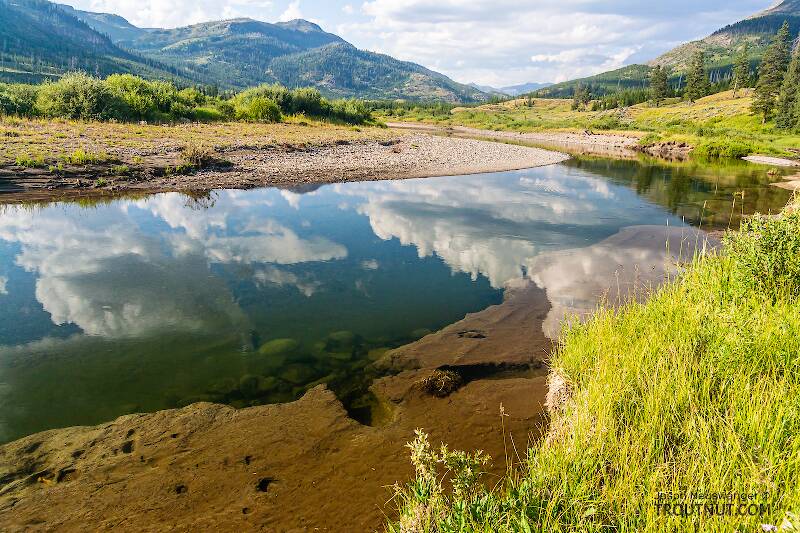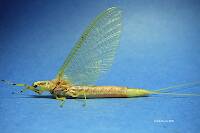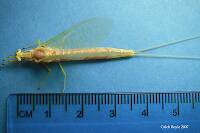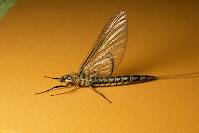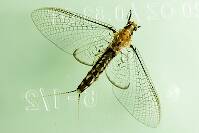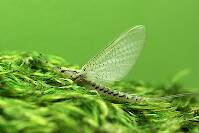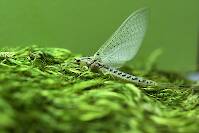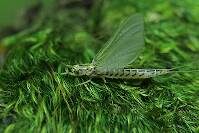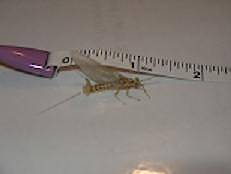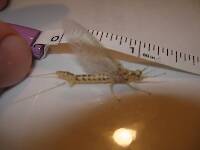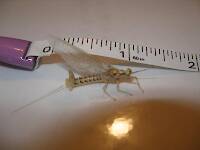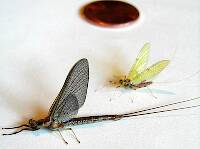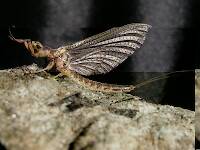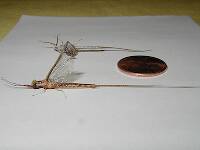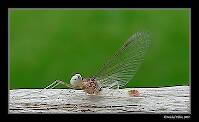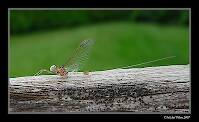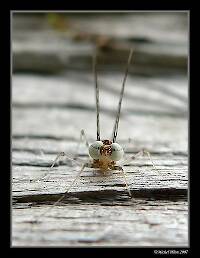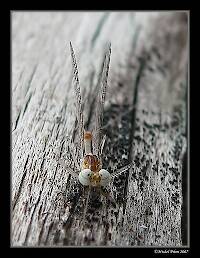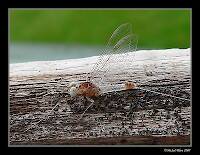
Salmonflies
Pteronarcys californica
The giant Salmonflies of the Western mountains are legendary for their proclivity to elicit consistent dry-fly action and ferocious strikes.
Featured on the forum

I caught this tiny larva without a case, but it seems to key pretty clearly to to Glossosomatidae. From there, the lack of sclerites on the mesonotum points to either Glossosoma or Anagapetus. Although it's difficult to see in a 2D image from the microscope, it's pretty clear in the live 3D view that the pronotum is only excised about 1/3 of its length to accommodate the forecoxa, not 2/3, which points to Glossosoma at Couplet 5 of the Key to Genera of Glossosomatidae Larvae.

Troutnut is a project started in 2003 by salmonid ecologist Jason "Troutnut" Neuswanger to help anglers and
fly tyers unabashedly embrace the entomological side of the sport. Learn more about Troutnut or
support the project for an enhanced experience here.
Konchu on Mar 7, 2012March 7th, 2012, 6:37 am EST
That wing character potentially is interesting. However, I'm aware of a variety of a single gene in true flies that can affect the presence or absence of a similar vein.
I'm uploading a figure from Spieth's (1941) classic work on Hexagenia that shows the dorsal (1) and ventral (2) color patterns of atrocaudata.
I'm uploading a figure from Spieth's (1941) classic work on Hexagenia that shows the dorsal (1) and ventral (2) color patterns of atrocaudata.
Entoman on Mar 7, 2012March 7th, 2012, 1:02 pm EST
Thanks for the abdominals, Luke. Well, they seem to point out that Lloyds "field method", while working for his home waters and perhaps Jason's as well, are not universal. As a genus, the dorsal markings (or lack thereof) are all over the map for these critters. Luke, are any considered reliable beyond noted regional variations already established? My sense is perhaps they aren't? The dorsals on Michel's specimen look to be limbata, unless there is a second line of bars we cannot see. The diagrams show that the dorsum can be lighter, so that is no longer an issue with either species.
Michel - Good observation on the detached vein below the stigmatic area. That could very well prove out to be significant - or not. The keen interest you are expressing by your efforts make it clear that you really would like to know with certitude what this is. I just don't know if we can go any further. Konchu can address this better than me, but I believe knowing with absolute certainty may need a copulated pair, or even require rearing nymphs. Even then, there is always the possibility that it is neither species or perhaps even a cryptic one.
BTW - I noticed on your website that you titled it as limbata without a modifier. Though size, distribution, population density, and perhaps even dorsal markings may be supportive of the probability, it's a stretch to be that definitive. If I were you, I'd list it simply as Hexagenia in the interest of accuracy.
Bottom line - as I mentioned before, this specimen does have a lot of similarities with atrocaudata, and if I were asked to hazard a guess without any of the other information you provided, I probably would have gone there myself. But, I'd be relunctant to declare a "new find" this much outsized and where it has never been reported before, based on the evidence in your photos alone. Especially with this genus!:)
Michel - Good observation on the detached vein below the stigmatic area. That could very well prove out to be significant - or not. The keen interest you are expressing by your efforts make it clear that you really would like to know with certitude what this is. I just don't know if we can go any further. Konchu can address this better than me, but I believe knowing with absolute certainty may need a copulated pair, or even require rearing nymphs. Even then, there is always the possibility that it is neither species or perhaps even a cryptic one.
BTW - I noticed on your website that you titled it as limbata without a modifier. Though size, distribution, population density, and perhaps even dorsal markings may be supportive of the probability, it's a stretch to be that definitive. If I were you, I'd list it simply as Hexagenia in the interest of accuracy.
Bottom line - as I mentioned before, this specimen does have a lot of similarities with atrocaudata, and if I were asked to hazard a guess without any of the other information you provided, I probably would have gone there myself. But, I'd be relunctant to declare a "new find" this much outsized and where it has never been reported before, based on the evidence in your photos alone. Especially with this genus!:)
"It's not that I find fishing so important, it's just that I find all other endeavors of Man equally unimportant... And not nearly as much fun!" Robert Traver, Anatomy of a Fisherman
Troutnut on Mar 7, 2012March 7th, 2012, 6:02 pm EST
If so the dorsals on Michels look to be limbata.
What makes you say that? It looks like the opposite to me. Looking at my specimens Michel reposted above, limbata has dark shading on the top left of each abdominal segment (in the side views above), while atrocaudata is shaded in the bottom right half. Michel's looks very much like my atrocaudata in that respect. My reading of this seems consistent with the figure from Spieth's paper, too, although the shading is quite faded in the PDF scan.
I'd be relunctant to declare a "new find" this much outsized and where it has never been reported before
I don't put too much weight on those. Distribution records are far from complete, especially for sparsely populated species. As for size, my atrocaudata specimens were up to 28mm, and were not exceptionally large. Spieth's listed body lengths for dried female imagoes were 19-24mm, live ones can clearly be longer. The listed body length ranges for dried imagoes of limbata were 18-20mm, 17-20mm, 14-19mm, 15-20mm, and 22-25mm, depending on subspecies and gender. Nothing suggests that atrocaudata is much smaller than limbata. Clearly limbata can grow much larger than 22-25mm, but I don't see why the same could not be true of atrocaudata, particularly in cold water where some nymphs might live 3 years before emerging instead of 1-2. Also, intending no offense to Michel, I have to wonder if his "at least 40mm" estimate might be on the high side -- a mistake very easy for anyone (including myself) to make when estimating the size of a large mayfly without using a ruler. 40mm would be anomalously large for either species. Something close to that is probably possible for both.
Jason Neuswanger, Ph.D.
Troutnut and salmonid ecologist
Troutnut and salmonid ecologist
Entoman on Mar 7, 2012March 7th, 2012, 7:35 pm EST
Hi Jason,
I think you missed my edit as your quotes are from when it first went up. I realized there were parts that were either unsupported with a rationale or too easy to misunderstand. Sorry about that.:) I'll respond to the edited version of your first quote for continuity.
First, I reserve the right to be wrong.:) Secondly, it looks to me like a single row of dark bars or dashes running down the center of a light field on the dorsum. It's visible in the photo I mentioned on Michel's website. This is at odds with your dorsal photos (that also show a dark field) and also at odds with Spieth in the upper segs. A single line of dark dashes on a pale field meeting the chevrons (or coming close) apically is a common character on many strains of limbata. Another character I noticed is while the double bars Gonzo mentioned on the terminal segs are clearly visible on your specimen, I would be hard pressed to describe the characters in the Spieth drawings that way. In fact, the terminal segs look more like the "trident" shape that Lloyd mentioned for limbata. Again, there's a lot of variability in this genus.
Yes, in this particular specimen of yours. There are lots of examples of limbata where this isn't the case, though.
I agree. But we have to start somewhere. The evidence has to be pretty compelling to override them, especially when there's other factors in their favor. If distribution were the only issue, it would be easier to put aside.
It's certainly possible, but we have to work with what we are given. I would think most macrophotograhers have a pretty good idea for size and somebody from Quebec for what a millimeter is (as opposed to a lot of Americans), but what gives me confidence in Michel's estimate is his notice of the detached vein. That demonstrates a pretty good aptitude for detail. I certainly didn't notice! :) For clarification though, perhaps Michel can answer whether he can remember if it was as long as the width of a quarter (coin) or substantially larger.
I assume anomaly would be the case with atrocaudatus, but have to disagree about limbata. I'm looking at a 15+ year old bottle of them from Fall River with the shriveled females running between 34mm & 36mm. In life they were in the 38mm to 40mm category. I've also collected them from other CA waters as well as OR waters in this size range. The warm water varieties (such as those that inhabit the Sacramento & San Joaquin rivers in the CA's Central Valley) usually average under 32mm. These are the records Day used to establish size for Hexagenia l. californica back in the '50's. He was totally unaware of our much larger cold water varieties. These are dense and established populations covering a large geographic area. I'm not aware of any such populations for atrocaudatus (even small and disparate ones), and they certainly inhabit regions with shorter growing seasons than CA.:)
I think you missed my edit as your quotes are from when it first went up. I realized there were parts that were either unsupported with a rationale or too easy to misunderstand. Sorry about that.:) I'll respond to the edited version of your first quote for continuity.
The dorsals on Michel's specimen look to be limbata, unless there is a second line of bars we cannot see.
What makes you say that?
First, I reserve the right to be wrong.:) Secondly, it looks to me like a single row of dark bars or dashes running down the center of a light field on the dorsum. It's visible in the photo I mentioned on Michel's website. This is at odds with your dorsal photos (that also show a dark field) and also at odds with Spieth in the upper segs. A single line of dark dashes on a pale field meeting the chevrons (or coming close) apically is a common character on many strains of limbata. Another character I noticed is while the double bars Gonzo mentioned on the terminal segs are clearly visible on your specimen, I would be hard pressed to describe the characters in the Spieth drawings that way. In fact, the terminal segs look more like the "trident" shape that Lloyd mentioned for limbata. Again, there's a lot of variability in this genus.
limbata has dark shading on the top left of each abdominal segment
Yes, in this particular specimen of yours. There are lots of examples of limbata where this isn't the case, though.
Distribution records are far from complete, especially for sparsely populated species.
I agree. But we have to start somewhere. The evidence has to be pretty compelling to override them, especially when there's other factors in their favor. If distribution were the only issue, it would be easier to put aside.
I have to wonder if his "at least 40mm" estimate might be on the high side...
It's certainly possible, but we have to work with what we are given. I would think most macrophotograhers have a pretty good idea for size and somebody from Quebec for what a millimeter is (as opposed to a lot of Americans), but what gives me confidence in Michel's estimate is his notice of the detached vein. That demonstrates a pretty good aptitude for detail. I certainly didn't notice! :) For clarification though, perhaps Michel can answer whether he can remember if it was as long as the width of a quarter (coin) or substantially larger.
Clearly limbata can grow much larger than 22-25mm, but I don't see why the same could not be true of atrocaudata, particularly in cold water where some nymphs might live 3 years before emerging instead of 1-2... 40mm would be anomalously large for either species.
I assume anomaly would be the case with atrocaudatus, but have to disagree about limbata. I'm looking at a 15+ year old bottle of them from Fall River with the shriveled females running between 34mm & 36mm. In life they were in the 38mm to 40mm category. I've also collected them from other CA waters as well as OR waters in this size range. The warm water varieties (such as those that inhabit the Sacramento & San Joaquin rivers in the CA's Central Valley) usually average under 32mm. These are the records Day used to establish size for Hexagenia l. californica back in the '50's. He was totally unaware of our much larger cold water varieties. These are dense and established populations covering a large geographic area. I'm not aware of any such populations for atrocaudatus (even small and disparate ones), and they certainly inhabit regions with shorter growing seasons than CA.:)
"It's not that I find fishing so important, it's just that I find all other endeavors of Man equally unimportant... And not nearly as much fun!" Robert Traver, Anatomy of a Fisherman
Pilonm on Mar 8, 2012March 8th, 2012, 2:59 am EST
Hello all,
Thank you for giving a second life to this post.
According to Yvon Dulude (from Quebec) who wrote a book on mayflies in Quebec,it exists 3 Hexagenia species in Quebec:
- H. limbata (the most common from very far)
- H. rigida
- H. atrocaudata (uncommon)
For the size, that subimago mayfly was captured in 2010 and I have to relay on my memory to remember the size (next time, be assured that I will use a ruler!!!). I remember that its size impressed me very well! But maybe I enlarge its size in my head since the pixel capture (also my mind was maybe affected by the fact that the forelegs were extended and by the long cerci). But I must say that the 3 first pictures I presented you was took with my 300mm lens and with this lens, I usually can't obtain very nice images of a subject of the size of 20-25mm:

Luckily, looking at my pictures I saw an object that will be as precise as a ruler in order to appreciate its size:

The material on which this Ephemeridae rests is my Barbecue cover! I count 20 "lines" from the end of the abdomen to the beginning of the head. (Is it the way you measure this insect?) So tonight I will try to reach my barbecue in my shed (which is blocked by snow) to measure its size via the cover!
I will let you know the exact size of the insect tomorrow :)
Cheers,
Michel
Thank you for giving a second life to this post.
According to Yvon Dulude (from Quebec) who wrote a book on mayflies in Quebec,it exists 3 Hexagenia species in Quebec:
- H. limbata (the most common from very far)
- H. rigida
- H. atrocaudata (uncommon)
For the size, that subimago mayfly was captured in 2010 and I have to relay on my memory to remember the size (next time, be assured that I will use a ruler!!!). I remember that its size impressed me very well! But maybe I enlarge its size in my head since the pixel capture (also my mind was maybe affected by the fact that the forelegs were extended and by the long cerci). But I must say that the 3 first pictures I presented you was took with my 300mm lens and with this lens, I usually can't obtain very nice images of a subject of the size of 20-25mm:

Luckily, looking at my pictures I saw an object that will be as precise as a ruler in order to appreciate its size:

The material on which this Ephemeridae rests is my Barbecue cover! I count 20 "lines" from the end of the abdomen to the beginning of the head. (Is it the way you measure this insect?) So tonight I will try to reach my barbecue in my shed (which is blocked by snow) to measure its size via the cover!
I will let you know the exact size of the insect tomorrow :)
Cheers,
Michel
Falsifly on Mar 8, 2012March 8th, 2012, 4:36 am EST
I have to say that this is becoming quite interesting.
Falsifly
When asked what I just caught that monster on I showed him. He put on his magnifiers and said, "I can't believe they can see that."
When asked what I just caught that monster on I showed him. He put on his magnifiers and said, "I can't believe they can see that."
Oldredbarn on Mar 8, 2012March 8th, 2012, 4:39 am EST
This is getting to be fun!!! :)
Spence
Spence
"Even when my best efforts fail it's a satisfying challenge, and that, after all, is the essence of fly fishing." -Chauncy Lively
"Envy not the man who lives beside the river, but the man the river flows through." Joseph T Heywood
"Envy not the man who lives beside the river, but the man the river flows through." Joseph T Heywood
Falsifly on Mar 8, 2012March 8th, 2012, 5:16 am EST
Yeah Spence you're right. This is getting to be like one of those good books you just can't lie down. I'd go fishing but I'm afraid I might miss something.:)
Falsifly
When asked what I just caught that monster on I showed him. He put on his magnifiers and said, "I can't believe they can see that."
When asked what I just caught that monster on I showed him. He put on his magnifiers and said, "I can't believe they can see that."
Entoman on Mar 8, 2012March 8th, 2012, 7:25 am EST
I'm glad you guys find this fascinating! So do I.:)
Michel - So, you found scientific lit showing atrocaudata in Quebec? I'll look up the title (let's hope its not only at the Ontario border).:) Also, that's good news about the grate. Unless the animal is perpendicular to the ridges, it will be foreshortened a bit and I'm counting 21, but it will still give us a good idea of size to help tell between the two. Maybe we can be a little more definitive for you after all.:)
Michel - So, you found scientific lit showing atrocaudata in Quebec? I'll look up the title (let's hope its not only at the Ontario border).:) Also, that's good news about the grate. Unless the animal is perpendicular to the ridges, it will be foreshortened a bit and I'm counting 21, but it will still give us a good idea of size to help tell between the two. Maybe we can be a little more definitive for you after all.:)
"It's not that I find fishing so important, it's just that I find all other endeavors of Man equally unimportant... And not nearly as much fun!" Robert Traver, Anatomy of a Fisherman
Oldredbarn on Mar 8, 2012March 8th, 2012, 7:57 am EST
Yeah Spence you're right. This is getting to be like one of those good books you just can't lie down. I'd go fishing but I'm afraid I might miss something.:)
Allan,
What I'm really worried about is an atrocaudata north of the border without its documents...:) How did that happen? These damn borders are so pourous...Where is Homeland Security when you need them? Maybe he's avoiding the draft...That doesn't make any sense...Maybe he's AWOL.
No point fishing Allan when we get this kind of entertainment...;) Hell! If this keeps up I may sell my rods.
Spence
"Even when my best efforts fail it's a satisfying challenge, and that, after all, is the essence of fly fishing." -Chauncy Lively
"Envy not the man who lives beside the river, but the man the river flows through." Joseph T Heywood
"Envy not the man who lives beside the river, but the man the river flows through." Joseph T Heywood
TNEAL on Mar 8, 2012March 8th, 2012, 8:05 am EST
Spence,
If you're havin' that much fun, why not just give the rods away?
If you're havin' that much fun, why not just give the rods away?
Oldredbarn on Mar 8, 2012March 8th, 2012, 9:51 am EST
If you're havin' that much fun, why not just give the rods away?
Tim,
You know better than that! :) One day they may set me free from this desk I'm chained to and I'll be standing in one of your secret fishing holes and you'll really be upset then...;)
I heard you guys got nailed with snow the other evening...That will be good for the rivers.
Spence
"Even when my best efforts fail it's a satisfying challenge, and that, after all, is the essence of fly fishing." -Chauncy Lively
"Envy not the man who lives beside the river, but the man the river flows through." Joseph T Heywood
"Envy not the man who lives beside the river, but the man the river flows through." Joseph T Heywood
Gutcutter on Mar 8, 2012March 8th, 2012, 2:28 pm EST
...What I'm really worried about is an atrocaudata north of the border without its documents...:) How did that happen? These damn borders are so pourous...
Spence
Maybe he was in the luggage when Connecticut-native Max Pacioretty signed his contract with the Habs
All men who fish may in turn be divided into two parts: those who fish for trout and those who don't. Trout fishermen are a race apart: they are a dedicated crew- indolent, improvident, and quietly mad.
-Robert Traver, Trout Madness
-Robert Traver, Trout Madness
Entoman on Mar 8, 2012March 8th, 2012, 6:44 pm EST
Ok, Ok... I was enjoying the bug debate, but I see the natives are getting restless which I take as a sign I've droned on long enough. So I'll concede it's probably atrocaudatus. From what I can see in this latest photo I wouldn't be surprised if it's well under 30mm. Proportionally, the abdomen looks too short and the wing too long to be one of the big girls. Besides, far be it from me to question distribution with an angling authority that writes in a language I can't read. :)
Spence - It apparently has its documents, it's just they're in French. :)LOL
Michel - It would sure be nice if you could provide info on the study the author used for reference. Hopefully, it's in the bibliography.
Spence - It apparently has its documents, it's just they're in French. :)LOL
Michel - It would sure be nice if you could provide info on the study the author used for reference. Hopefully, it's in the bibliography.
"It's not that I find fishing so important, it's just that I find all other endeavors of Man equally unimportant... And not nearly as much fun!" Robert Traver, Anatomy of a Fisherman
Pilonm on Mar 9, 2012March 9th, 2012, 5:32 am EST
Hello all,
I was not able to go to my shed yesterday evening but will go for sure tomorrow and then we will know ;)
I'm not the owner of the book and don't have access to it. Here is the link on amazon:
http://www.amazon.com/EPHEMERES-DU-PECHEUR-QUEBECOIS/dp/2761909593
I will try to contact the author...
Cheers,
Michel
I was not able to go to my shed yesterday evening but will go for sure tomorrow and then we will know ;)
I'm not the owner of the book and don't have access to it. Here is the link on amazon:
http://www.amazon.com/EPHEMERES-DU-PECHEUR-QUEBECOIS/dp/2761909593
I will try to contact the author...
Cheers,
Michel
Entoman on Mar 9, 2012March 9th, 2012, 9:44 am EST
I will try to contact the author...
Good idea. At $200 for a used copy, that's the only way we're gonna find out! :)
"It's not that I find fishing so important, it's just that I find all other endeavors of Man equally unimportant... And not nearly as much fun!" Robert Traver, Anatomy of a Fisherman
Pilonm on Mar 10, 2012March 10th, 2012, 6:10 am EST
Hello all,
Sad news: the door of my shed don't want to open because the ground moved by the frost and I can't open it without broken the door... So we will have to wait few weeks before I will be able to enter the shed and measure the cover of my barbecue...
Be assured that once I will have it, I will post the size of this Hexagonia!
Cheers,
Michel
Sad news: the door of my shed don't want to open because the ground moved by the frost and I can't open it without broken the door... So we will have to wait few weeks before I will be able to enter the shed and measure the cover of my barbecue...
Be assured that once I will have it, I will post the size of this Hexagonia!
Cheers,
Michel
Troutnut on Mar 10, 2012March 10th, 2012, 4:33 pm EST
I'll look forward to that data!
Jason Neuswanger, Ph.D.
Troutnut and salmonid ecologist
Troutnut and salmonid ecologist
Oldredbarn on Mar 11, 2012March 11th, 2012, 1:06 pm EDT
Maybe he was in the luggage when Connecticut-native Max Pacioretty signed his contract with the Habs
We are getting a bit obscure here, but your quess is as good as mine Tony. :)
My final thoughts on this bug is we need to get Michel & Jason together to fill in some of our gaps...They both are excelent with the camera lens! ;)
Spence
"Even when my best efforts fail it's a satisfying challenge, and that, after all, is the essence of fly fishing." -Chauncy Lively
"Envy not the man who lives beside the river, but the man the river flows through." Joseph T Heywood
"Envy not the man who lives beside the river, but the man the river flows through." Joseph T Heywood
Quick Reply
Related Discussions
Topic
Replies
Last Reply
1
Aug 1, 2008
by Troutnut
by Troutnut
3
May 31, 2016
by Oldredbarn
by Oldredbarn
10
Jun 30, 2009
by Jmd123
by Jmd123
5
Oct 17, 2007
by Pilonm
by Pilonm

